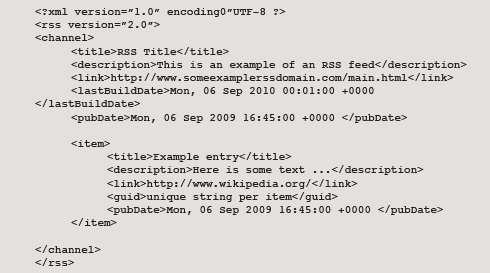JES2RSS Überblick
JES2RSS, or JES2FTP with RSS, provides a widely supported mechanism to publish report contents and enables notification of the new items through RSS clients.
A Web Feed file is an XML file that contains a list of items and links to contents that are in the feed. When a web publisher, like JES2RSS, has a new item to publish it creates the report contents and stores it on a server and then it goes to the RSS server and creates or updates the XML Web Feed file.
 RSS (most commonly expanded as Really Simple Syndication) is a family of web feed formats used to publish frequently updated works such as blog entries, news headlines, audio, and videos in a standardized format. An RSS document (which is called a “feed”, “web feed” or “channel”) includes full or summarized text, plus metadata such as publishing dates and authorship. Web feeds benefit publishers by letting them syndicate content automatically. They benefit readers who want to subscribe to timely updates from favored websites or to aggregate feeds from many sites into one place. RSS feeds can be read using software called an “RSS reader”, “feed reader”, or “aggregator”, which can be web-based, desktop-based, or mobile-device-based. A standardized XML file format allows the information to be published once and viewed by many different programs. The user subscribes to a feed by entering into the reader the feed’s URI or by clicking an RSS icon in a web browser that initiates the subscription process. The RSS reader checks the user’s subscribed feeds regularly for new work, downloads any updates that it finds, and provides a user interface to monitor and read the feeds.
As RSS files are essentially XML formatted plain text, the RSS file itself is relatively easily read both by automated processes and by humans alike. An example file could have contents such as the following. This could be placed on any appropriate communication protocol for file retrieval, such as http or ftp, and reading software would use the information to present a neat display to the end user.
RSS (most commonly expanded as Really Simple Syndication) is a family of web feed formats used to publish frequently updated works such as blog entries, news headlines, audio, and videos in a standardized format. An RSS document (which is called a “feed”, “web feed” or “channel”) includes full or summarized text, plus metadata such as publishing dates and authorship. Web feeds benefit publishers by letting them syndicate content automatically. They benefit readers who want to subscribe to timely updates from favored websites or to aggregate feeds from many sites into one place. RSS feeds can be read using software called an “RSS reader”, “feed reader”, or “aggregator”, which can be web-based, desktop-based, or mobile-device-based. A standardized XML file format allows the information to be published once and viewed by many different programs. The user subscribes to a feed by entering into the reader the feed’s URI or by clicking an RSS icon in a web browser that initiates the subscription process. The RSS reader checks the user’s subscribed feeds regularly for new work, downloads any updates that it finds, and provides a user interface to monitor and read the feeds.
As RSS files are essentially XML formatted plain text, the RSS file itself is relatively easily read both by automated processes and by humans alike. An example file could have contents such as the following. This could be placed on any appropriate communication protocol for file retrieval, such as http or ftp, and reading software would use the information to present a neat display to the end user.

 RSS (most commonly expanded as Really Simple Syndication) is a family of web feed formats used to publish frequently updated works such as blog entries, news headlines, audio, and videos in a standardized format. An RSS document (which is called a “feed”, “web feed” or “channel”) includes full or summarized text, plus metadata such as publishing dates and authorship. Web feeds benefit publishers by letting them syndicate content automatically. They benefit readers who want to subscribe to timely updates from favored websites or to aggregate feeds from many sites into one place. RSS feeds can be read using software called an “RSS reader”, “feed reader”, or “aggregator”, which can be web-based, desktop-based, or mobile-device-based. A standardized XML file format allows the information to be published once and viewed by many different programs. The user subscribes to a feed by entering into the reader the feed’s URI or by clicking an RSS icon in a web browser that initiates the subscription process. The RSS reader checks the user’s subscribed feeds regularly for new work, downloads any updates that it finds, and provides a user interface to monitor and read the feeds.
As RSS files are essentially XML formatted plain text, the RSS file itself is relatively easily read both by automated processes and by humans alike. An example file could have contents such as the following. This could be placed on any appropriate communication protocol for file retrieval, such as http or ftp, and reading software would use the information to present a neat display to the end user.
RSS (most commonly expanded as Really Simple Syndication) is a family of web feed formats used to publish frequently updated works such as blog entries, news headlines, audio, and videos in a standardized format. An RSS document (which is called a “feed”, “web feed” or “channel”) includes full or summarized text, plus metadata such as publishing dates and authorship. Web feeds benefit publishers by letting them syndicate content automatically. They benefit readers who want to subscribe to timely updates from favored websites or to aggregate feeds from many sites into one place. RSS feeds can be read using software called an “RSS reader”, “feed reader”, or “aggregator”, which can be web-based, desktop-based, or mobile-device-based. A standardized XML file format allows the information to be published once and viewed by many different programs. The user subscribes to a feed by entering into the reader the feed’s URI or by clicking an RSS icon in a web browser that initiates the subscription process. The RSS reader checks the user’s subscribed feeds regularly for new work, downloads any updates that it finds, and provides a user interface to monitor and read the feeds.
As RSS files are essentially XML formatted plain text, the RSS file itself is relatively easily read both by automated processes and by humans alike. An example file could have contents such as the following. This could be placed on any appropriate communication protocol for file retrieval, such as http or ftp, and reading software would use the information to present a neat display to the end user.

